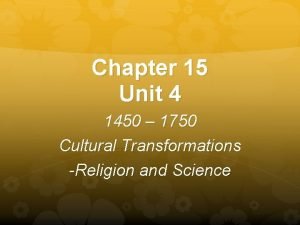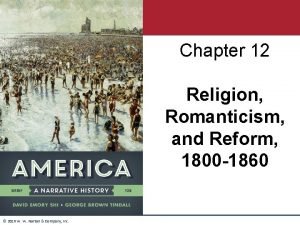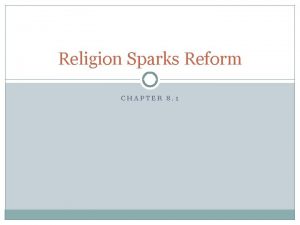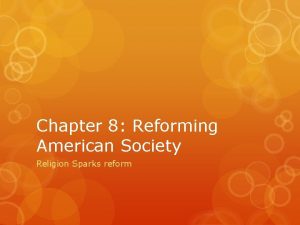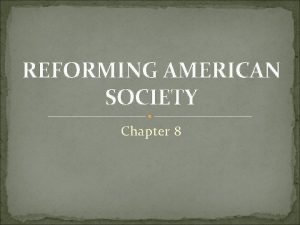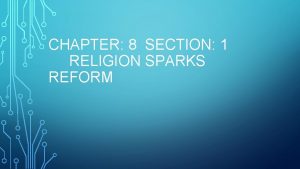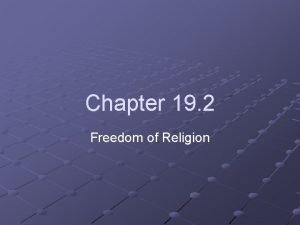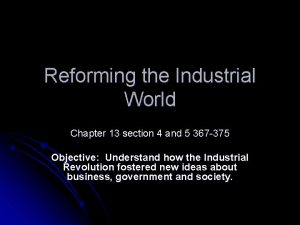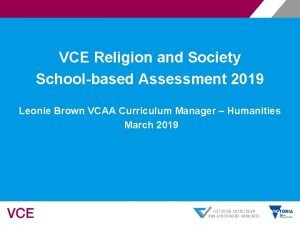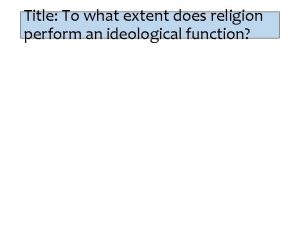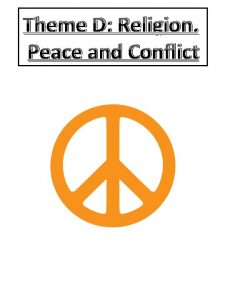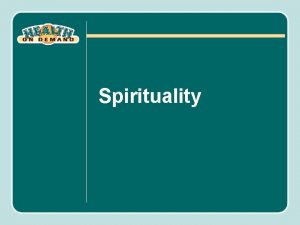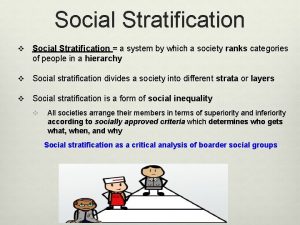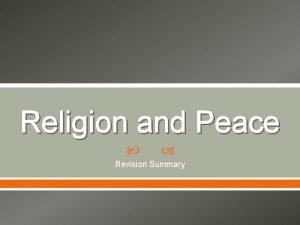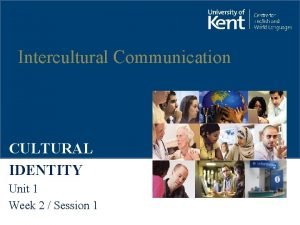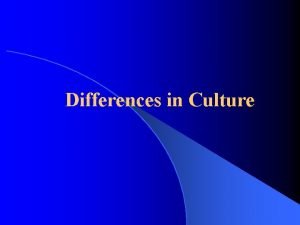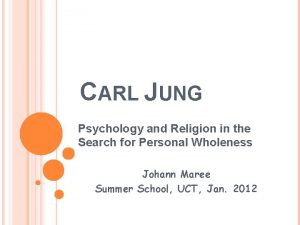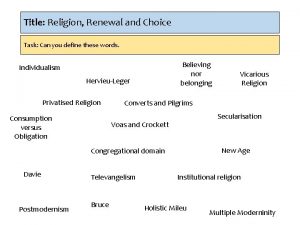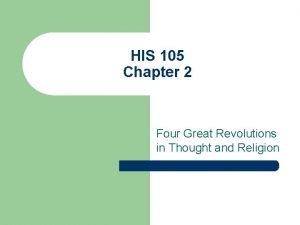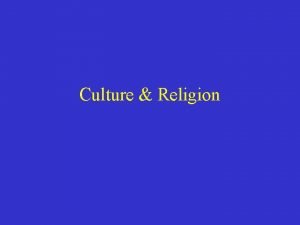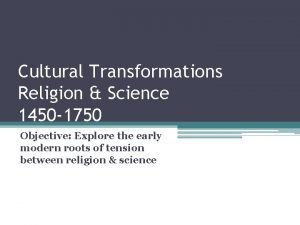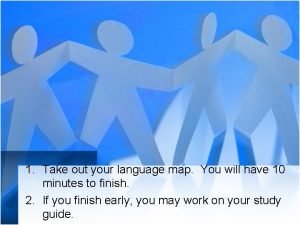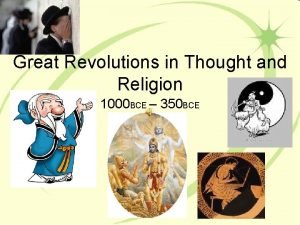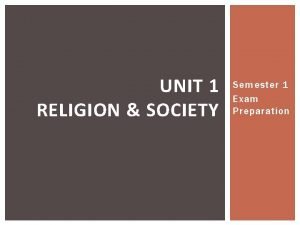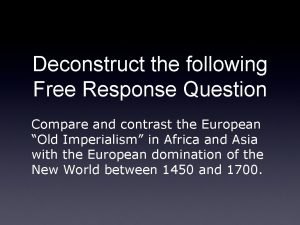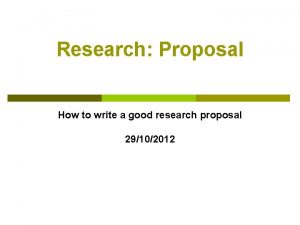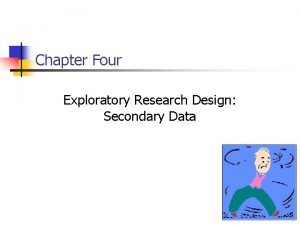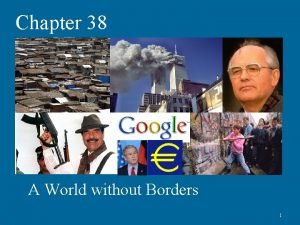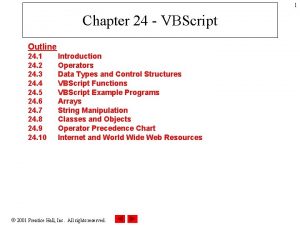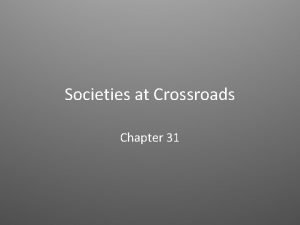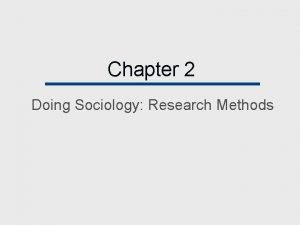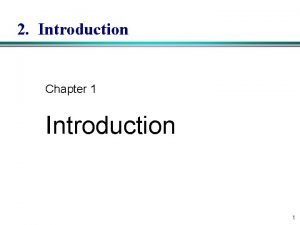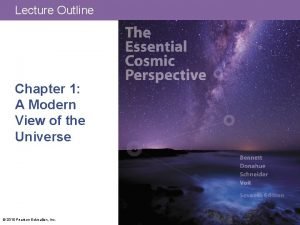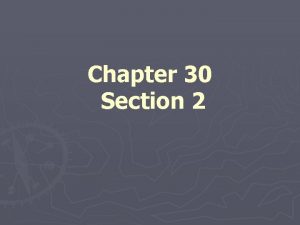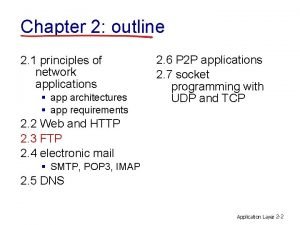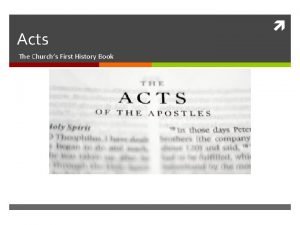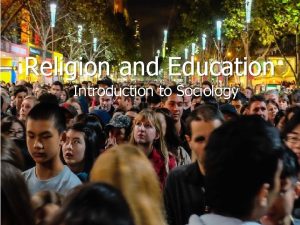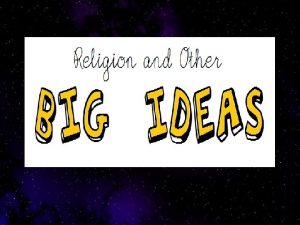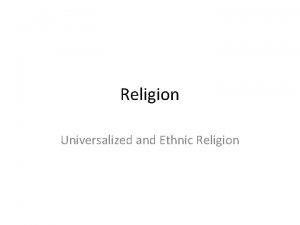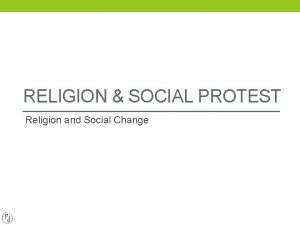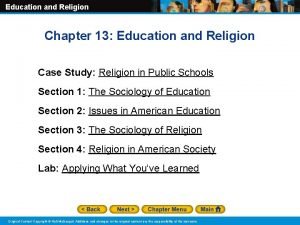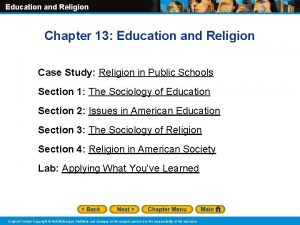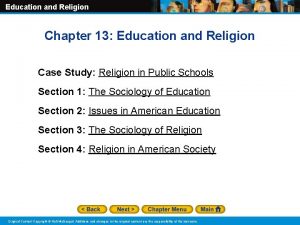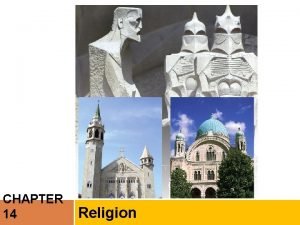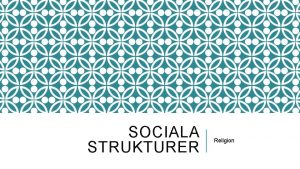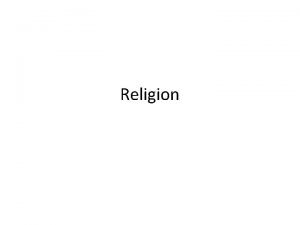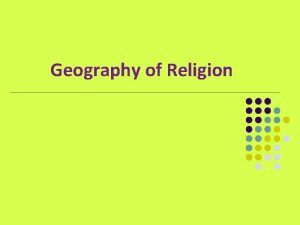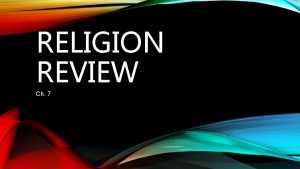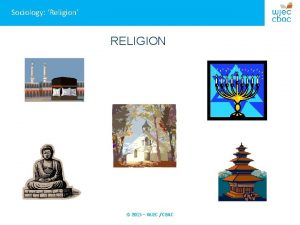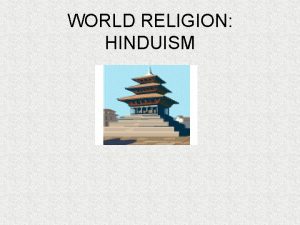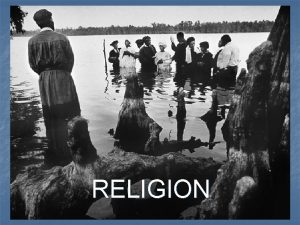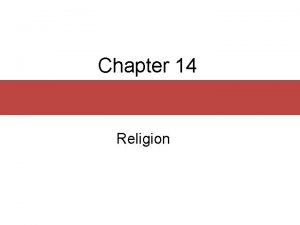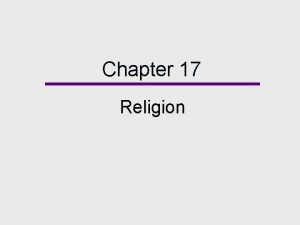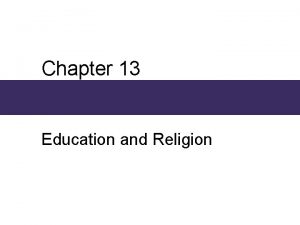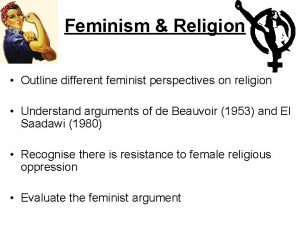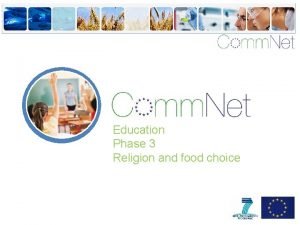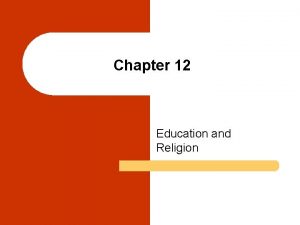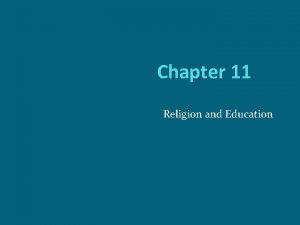Chapter 12 Education and Religion Chapter Outline Education

















































- Slides: 49

Chapter 12 Education and Religion

Chapter Outline § Education and Religious Institutions § Theoretical Perspectives on Education § Current Controversies in American Education § College and Society § Understanding Religion § Tension Between Religion and Society § Religion in the United States § Where This Leaves Us

Educational and Religious Institutions § Education and religion are central components of any nation and have profound effects on our society and individuals. § Almost all people in the U. S. have attended school, and a strong majority practice a religion. § All people are affected by the norms and values of these two institutions.

Theoretical Perspectives on Education § The educational institution is the social structure responsible for the formal transmission of knowledge. Nearly 3 of every 10 people in the U. S. participates in education daily as students or staff. As taxpayers, parents, students, or educational professionals, we are all involved in the institution of education in some way. § §

Theoretical Perspectives on Education Structural-Functional Theory: Functions of Education § Concerned with the consequences of educational institutions for the maintenance of society. § Educational system is designed to keep society running smoothly: ◦ Training and knowledge – of each generation ◦ Socialization – discipline, obedience, cooperation, punctuality, cultural knowledge ◦ Sorting – channel students based on their abilities ◦ Promoting Change – critical and analytical skills

Education and Culture In all societies, education is an important means of reproducing culture. In addition to skills such as reading and writing, children learn many of the dominant cultural values. In Japan, school uniforms emphasize group solidarity over individual achievement.

Theoretical Perspectives on Education Conflict Theory: Education and the Perpetuation of Inequality § Education as a Capitalist Tool – hidden curriculum teaches obedience and conformity. § Education as a Cultural Tool – teaches the cultural perspective of the dominant culture. § Education as a Status Marker – credentials are often a surrogate for race, gender and social class. Credentialism is a social bias based on credentials. § Unequal Education and Inequality – use of education as a status marker reinforced by unequal opportunities for education across society.

Unequal Education It is difficult for children to learn in crowded classrooms that lack proper heating or cooling; to be taught by beginning or substitute teachers; to have to share outdated textbooks. Such conditions are more common in poor and minority communities.

Theoretical Perspectives on Education Symbolic Interactionism: The Selffulfilling Prophecy § Focus on the processes. The “learning” process can vary greatly across society. § Teachers may hold racist and classist views common in U. S. society resulting in bias. § Students possess disparate “cultural capital” which helps or hinders interactions with teachers. § Teachers grew up in a society with racist, sexist and classist biases. Biases are embedded in their views and result in assumptions and perpetuate bias.

Sociology and you… What social class advantages or disadvantages did you bring with you to college? Did you grow up with parents who read the New York Times…or with parents who couldn’t read, or couldn’t read English? Did your parents pay for extra tutoring, music lessons, theater tickets, a computer or tablet, or a junior year abroad…. or did your parents need you to work to help them pay the household bills? Did your high school have all the latest facilities…or a leaky roof and outdated textbooks? These advantages and disadvantages will continue to affect you as you go through college.

Current Controversies in American Education Tracking § Use of early evaluation to determine the § educational programs a child will be encouraged to follow Based primarily on reading ability: ◦ Some directed to college preparatory tracks ◦ Some directed into general/vocational education ◦ Others directed into special (remedial) education § Research shows modest benefit if students are assigned to high-ability groups and significant disadvantages for students placed in low-ability groups.

Current Controversies in American Education High-Stakes Testing § Federal law now requires schools to measure student performance using standardized tests. § Students now must pass “high-stakes” tests before they can move to a higher grade. § Teachers and schools are evaluated and punished or rewarded on the basis of these tests. § Often programs in art music, physical education, and languages are dropped as more resources put into tested areas.

High-Stakes Testing The rise of high-stakes tests has pressed schools to pay more attention to how their students are doing. Classes in subjects not on the test have been dropped. Teachers focus on test taking skills rather than teaching the subject matter.

Current Controversies in American Education School Choice § Concern about the quality of American public education has led to support for school choice. § Options including tuition vouchers, tax credits, § § magnet schools, charter schools, and home schooling. The best current research suggests that children sent to charter schools do no better and sometimes do worse than children in public schools. (Renzulli & Roscigno, 2007) Opponents of school choice point to negative consequences of reinforcing social inequality and segregation. (Saporito & Sohoni, 2006)

College and Society Who Goes? § Until recently, non-Hispanic white males were the group most likely to be enrolled in college. § Rates of women in all ethnic groups attending college increased steadily. § White men are still most likely to receive § professional and doctoral degrees and be in field with highest income. Ethnic and social class differences affect college attendance greater than sex differences.

Percentage of High School Graduates Ages 18 to 21 Enrolled in College, by Race, Ethnicity, and Sex, 1975 and 2009 As depicted in this chart, differences in high school graduation rates among racial and ethnic groups is an important factor in who attends college.

College and Society Why Go? § Learn logic, critical thinking, civic engagement § College prepares students for middle class jobs: shapes demeanor, language, and belief in their intellectual abilities.

Socioeconomic Consequences of Higher Education Going to college pays off. Those who graduate college earn twothirds more than high school graduates, are much more likely to be employed, and are more likely to have a professional job.

Understanding Religion What is Religion? § The institution of religion is an important part § § of social life. It is intertwined with politics and culture and involved in integration and conflict. Religion is a system of beliefs and practices related to sacred things that unites believers into a moral community. Sociologists examine how culture, society, and other social forces affect religion, and how religion affects individuals and social structure.

Understanding Religion Why Religion? § Every society has forms of religious activity and expressions of religious behavior. § Religion is a fundamental feature in all societies. § It helps individuals interpret and cope with events beyond our control and understanding. § Beliefs and rituals develop as a way to appease the greater force.

Distribution of World Religions Christianity is the dominant religion in the Americas, Europe, and Australia, but elsewhere other religions are far more common.

Understanding Religion Why Religion Now? The Rise of Fundamentalism § Until the 1970 s, scholars thought that as science advanced, secularization would increase. § Secularization is the process of transferring objects, ideas, or events from the sacred realm to the non-sacred (secular) realm. § While there has been some drop in American religiosity, fundamentalism has grown dramatically in the last 30 years.

Changing Religious Commitment 1962– 2010 During the last 40 years, there has been a small drop in the proportion of Americans who belong to a religion, a bigger drop in those who say religion is very important in their lives, and a sharp drop in the proportion who think that the Bible is the actual word of God.

Understanding Religion Why Religion Now? The Rise of Fundamentalism refers to religious movements that: ◦ Believe heir most sacred book or books to be the literal word of God ◦ Accept traditional interpretations of those books ◦ Stress the importance of living in ways that mesh with those traditional interpretations

Theoretical Perspectives on Religion Durkheim: Structural-Functional Theory of Religion Three elementary forms of religion: 1. Human experience is divided into: Profane – all that is routine in everyday world; that we understand control. Sacred – events and things we hold in awe and reverence; that we cannot understand or control 2. A set of beliefs about the supernatural that help people cope with the uncertainties of life. 3. A body of rituals or practices.

Theoretical Perspectives on Religious rituals help individuals cope with events that are beyond human understanding, such as death, illness, drought, and famine.

Theoretical Perspectives on Religion Durkheim: Structural-Functional Theory of Religion The Functions of Religion: At the societal level, religion gives tradition a moral imperative. At the personal level, religion provides support, consolation, and reconciliation in times of need. Religious participation gives feeling of “belongingness” which creates the moral community, or community of believers. § § §

Theoretical Perspectives on Religion Marx and Beyond: Conflict Theory and Religion § Marx saw religion as an “opiate of the masses. ” § Modern conflict theorists are more interested § in how religion may contribute to or reduce conflicts between social groups. Focus on the dialectic—the contradictions between existing institutions that lead to social change. Social change can foster change in society’s religions.

Theoretical Perspectives on Religion Weber: Religion as an Independent Force § Weber combined ideas from structural and conflict perspectives. § Religion is the search for knowledge about what is unknown. § Changes in religious ideology can stimulate social change. § Charismatic leadership is influential. § Protestant Ethic: the belief that rationalism, work, and plain living are moral virtues; idleness and indulgence are sinful.

Tension between Religion and Society Each religion confronts two contradictory yet complementary tendencies: 1) The tendency to reject the world 2) The tendency to compromise with the world i. e. , if “it is easier for a camel to go through the eye of a needle than for a rich man to enter the kingdom of God, ” must a church require that all its members forsake wealth? How religions resolve these dilemmas is central to their eventual form and character.

Tension between Religion and Society Churches Religious organizations that are institutionalized, have endured for generations, are supported by and support society’s norms and values, and are an active part of society are called churches. State church – strongly supported or mandated by the government Denomination – a church that accommodates the state and other churches Structure and function – formal bureaucracy; hierarchal positions, official creeds, formal rituals

Tension between Religion and Society Sects Religious organizations that arise in active rejection of changes they find repugnant in churches are called sects. Structure and function of sects: Membership is often the result of conversion or emotional experience. § § Services are more informal than in churches. §Doctrines emphasize “otherworldly” rewards; scriptures considered literal and divine in origin. §Like primary groups: small, informal, loyal.

Tension between Religion and Society Although members of the Amish sect reject much of modern life for themselves, they have accommodated to living in the modern world around them.

Tension between Religion and Society New Religious Movements (NRMs) Religious or spiritual movements begun in recent decades and not connected to mainstream religions; also known as cults. Structure and function of NRMs: § Strongly resemble those of sects §Members elect to join NRM rather than follow parents’ religion §Attract people whose needs have not been met by mainstream religions.

A Case Study: Islam was founded in the 7 th century A. D. 21% of world population is Muslim; likely to be the largest religion in the world in the next 50 years. Islam as a churchlike religion: Islam is a state church in Iran; a denomination in Egypt. Islam as a sect-like Religion: Increase in Islamic fundamentalism Islam as a NRM: The Nation of Islam known as ‘Black Muslims’ Islamic moderates and fundamentalists co-exist § § Five Pillars of Islam: 1. Profess faith in one almighty God and in Muhammad 2. Pray five times daily 3. Make charitable donations 4. Fast during day for Ramadan 5. Make at least one pilgrimage to Mecca § §

Religion in the United States Trends in U. S. Religious Membership The Rise of Emerging Churches are linked by: 1) the belief that Americans and modern Christian churches are impersonal, bureaucratic, and inauthentic 2) an emphasis on informal rituals; a more open perspective toward scripture and behavior; and living a life of mission, faith, and community The Rise in “No Religion” – Currently 14% of U. S. residents claim no religion (up from 8% in 1990). Atheists believe that there is no God; agnostics are uncertain of the existence of God.

Religion in the United States Trends in Religiosity § Religiosity is an individual’s level of commitment to religious beliefs and to acting on those beliefs. § Religious economy refers to the competition between religious organizations to provide better “consumer products” thereby creating greater “market demand” for their own products. College graduates and non-graduates are equally likely to hold conservative religious beliefs.

Religion in the United States Consequences of Religiosity § People who are more religious tend to be: ◦ Healthier, happier and more satisfied with their lives – benefits from sense of belonging to a religious community ◦ More conservative in attitudes about family; in supporting conservative political movements § Religion and church can promote social change. § Church members don’t always adopt the views of their church; sometimes this results in a split from the central church.

Religion in the United States U. S. Civil Religion § Civil religion is the set of institutionalized § § rituals, beliefs, and symbols sacred to the U. S. nation. Important source of unity for the U. S. ◦ Beliefs: The U. S. operates “under God” ◦ Symbols: The flag ◦ Rituals: Pledge of Allegiance Singing of National Anthem Sacred principles: liberty, justice, and freedom

Where This Leaves Us § § Structure-functional theory: Schools and churches are preservers of tradition. Both institutions socialize the young, stressing acceptance of authority and contemporary social arrangements (including inequality). Conflict theory: See schools and churches on the forefront of social change and conflict. Symbolic interaction: Explores the processes of relational conflict, group interaction, and institutional social change. One such process is the “self-fulfilling prophecy. ” The vital roles that education and religion play in creating or impeding social cannot be ignored.

Quick Quiz

1. Which of the following is the best definition of the education institution? It is concerned with: A. B. C. D. solving problems of knowledge. the formal transmission of knowledge. the sociology of knowledge. the processes of learning.

Answer: B The education institution is concerned with the formal transmission of knowledge.

2. Which dysfunction of the educational system is at the heart of the conflict theory criticisms of education? A. B. C. D. the development of a youth subculture the development of a generation gap the perpetuation of inequality custodial care

Answer: C The perpetuation of inequality is at the heart of the conflict theory criticisms of education.

3. Why do the schools track? A functionalist would argue that: A. it is meant to perpetuate the current system of inequality. B. low-ability students do not care. C. parents of high-ability students pay higher property taxes, so they should get more out of it. D. it makes it easier for administration.

Answer: D A functionalist would argue that tracking occurs because it makes it easier for administration.

4. Sociologists define religion as: A. any organized group of people who believe in God. B. a system of beliefs and practices related to sacred things that unites people in a moral community. C. a way of life shared by members of society. D. all of the material and nonmaterial aspects of culture that have to do with religious worship.

Answer: B Sociologists define religion as a system of beliefs and practices related to sacred things that unites people in a moral community.
 Secneer
Secneer Sandwich
Sandwich Ursula de jesus ap world history
Ursula de jesus ap world history Chapter 12: religion, romanticism, and reform, 1800–1860
Chapter 12: religion, romanticism, and reform, 1800–1860 Chapter 8 section 1 religion sparks reform
Chapter 8 section 1 religion sparks reform Chapter 8 section 1 guided reading religion sparks reform
Chapter 8 section 1 guided reading religion sparks reform Chapter 8 section 1 religion sparks reform
Chapter 8 section 1 religion sparks reform Chapter 8 section 1 religion sparks reform
Chapter 8 section 1 religion sparks reform Chapter 19 section 2 freedom of religion
Chapter 19 section 2 freedom of religion Chapter 8 section 1 religion sparks reform
Chapter 8 section 1 religion sparks reform Religion and society study design
Religion and society study design Religion and conflict theory
Religion and conflict theory What is the difference between christian and catholic
What is the difference between christian and catholic What is the difference between spirituality and religion
What is the difference between spirituality and religion Caste system versus class system
Caste system versus class system Sign versus symbol
Sign versus symbol Religion and peace essay hsc
Religion and peace essay hsc National study of youth and religion
National study of youth and religion Difference between culture and religion
Difference between culture and religion Difference between religion and culture
Difference between religion and culture Meaning
Meaning Carl jung psychology and religion
Carl jung psychology and religion Religion renewal and choice
Religion renewal and choice East river valley religion
East river valley religion Anasazi social structure
Anasazi social structure Four great revolutions in thought and religion
Four great revolutions in thought and religion Geography and culture of christianity
Geography and culture of christianity Cultural transformations religion and science
Cultural transformations religion and science Which pairing of sacred text and religion is correct
Which pairing of sacred text and religion is correct Aryan food
Aryan food Religion and society exam
Religion and society exam Religion supplies the pretext and gold the motive
Religion supplies the pretext and gold the motive Als vs formal education
Als vs formal education Difference between health education and health promotion
Difference between health education and health promotion Labeling theory of deviance examples
Labeling theory of deviance examples Romans outline by chapter
Romans outline by chapter Research proposal elements
Research proposal elements Give me liberty ch 27
Give me liberty ch 27 Methodology chapter outline
Methodology chapter outline Chapter 38 a world without borders outline
Chapter 38 a world without borders outline Vbscript
Vbscript Hunger games chapter 11 questions and answers
Hunger games chapter 11 questions and answers Chapter 31 societies at crossroads
Chapter 31 societies at crossroads Ap world history chapter 28 outline
Ap world history chapter 28 outline Chapter 2 learning goals outline sociology answers
Chapter 2 learning goals outline sociology answers Chapter 1 outline
Chapter 1 outline Chapter 1 outline
Chapter 1 outline Chapter 30
Chapter 30 Chapter 2 outline
Chapter 2 outline Book of acts study outline
Book of acts study outline


